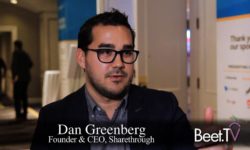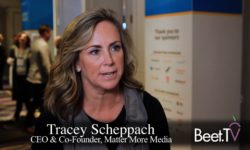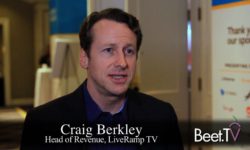SAN FRANCISCO – Since its merger with Rovi, TiVo has been on a mission to bulk up its television viewership data by working with service providers “to acquire as much TV viewership data as we could amass,” says Walt Horstman, the company’s SVP/GM, Automated Media & Advertising.
“So that’s been very successful and we have a large population of TV viewership data, beyond just from the TiVo devices but where we have software embedded across providers and even beyond that,” Horstman says in this interview with Beet.TV at the recent RampUp 2018 conference by LiveRamp.
TiVo just announced that it’s reached two million active matched households across all DMA’s “and that number is growing quite rapidly.” The company’s goal is to reach three million “very shortly and then throughout the year scaling up to five to seven million plus,” Horstman says.
“The company TiVo today is much bigger than TiVo the device and that’s part of the story that we’re taking to market.”
He stresses that TiVo has unfettered rights to use the TV viewership data in matching with multiple datasets so that it can “understand the science of what is changing consumer behavior when a household is exposed to a TV campaign, and that is very exciting.”
All personally identifiable information about TV viewers is removed before it reaches TiVo, according to Horstman. Identifiers appended to the TV dataset can be matched across the advertising ecosystem for first- and third-party data.
In the wake of its launching the Targeted Audience Delivery platform, which sits atop all of the company’s TV data, TiVo has been meeting with agencies and advertisers about providing deterministic, exposed households to a specific TV campaign.
“What’s exciting about this is we can go to a brand and say ‘bring your first party data into a safe haven like LiveRamp match it to our TV viewership data.’ We can then run that against the campaign that you just did in the last quarter and then provide you the exact households that were exposed an unexposed to your TV campaign.”
Besides revealing whether TV ad exposure drove incremental activity through an existing customer group, brands can then use those segments to activate those same households “in any kind of digital, mobile or connected-TV activation as well,” Horstman says.
This video is part of a series produced in San Francisco at the RampUp 2018 conference. The series is sponsored by Alphonso. For more videos from the series, please visit this page.













































